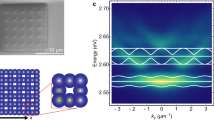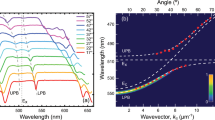Abstract
A Bose–Einstein condensate (BEC) is a state of matter in which extensive collective coherence leads to intriguing macroscopic quantum phenomena1. In crystalline semiconductor microcavities, bosonic quasiparticles, known as exciton–polaritons, can be created through strong coupling between bound electron–hole pairs and the photon field2. Recently, a non-equilibrium BEC (ref. 3) and superfluidity4,5 have been demonstrated in such structures. With organic crystals grown inside dielectric microcavities, signatures of polariton lasing have been observed6. However, owing to the deleterious effects of disorder and material imperfection on the condensed phase7,8,9, only crystalline materials of the highest quality have been used until now. Here we demonstrate non-equilibrium BEC of exciton–polaritons in a polymer-filled microcavity at room temperature. We observe thermalization of polaritons and, above a critical excitation density, clear evidence of condensation at zero in-plane momentum, namely nonlinear behaviour, blueshifted emission and long-range coherence. The key signatures distinguishing the behaviour from conventional photon lasing are presented. As no crystal growth is involved, our approach radically reduces the complexity of experiments to investigate BEC physics and paves the way for a new generation of opto-electronic devices, taking advantage of the processability and flexibility of polymers.
This is a preview of subscription content, access via your institution
Access options
Subscribe to this journal
Receive 12 print issues and online access
$259.00 per year
only $21.58 per issue
Buy this article
- Purchase on Springer Link
- Instant access to full article PDF
Prices may be subject to local taxes which are calculated during checkout




Similar content being viewed by others
References
Pitaevskii, L. & Stringari, S. Bose–Einstein Condensation (Clarendon, 2003).
Weisbuch, C., Nishioka, M., Ishikawa, A. & Arakawa, Y. Observation of the coupled exciton–photon mode splitting in a semiconductor quantum microcavity. Phys. Rev. Lett. 69, 3314–3317 (1992).
Kasprzak, J. et al. Bose–Einstein condensation of exciton polaritons. Nature 443, 409–414 (2006).
Lagoudakis, K. G. et al. Quantized vortices in an exciton–polariton condensate. Nature Phys. 4, 706–710 (2008).
Amo, A. et al. Superfluidity of polaritons in semiconductor microcavities. Nature Phys. 5, 805–810 (2009).
Kéna-Cohen, S. & Forrest, S. R. Room-temperature polariton lasing in an organic single-crystal microcavity. Nature Photon. 4, 371–375 (2010).
Malpuech, G., Solnyshkov, D. D., Ouerdane, H., Glazov, M. M. & Shelykh, I. Bose glass and superfluid phases of cavity polaritons. Phys. Rev. Lett. 98, 206402 (2007).
Baas, A. et al. Synchronized and desynchronized phases of exciton–polariton condensates in the presence of disorder. Phys. Rev. Lett. 100, 170401 (2008).
Krizhanovskii, D. N. et al. Coexisting nonequilibrium condensates with long-range spatial coherence in semiconductor microcavities. Phys. Rev. B 80, 045317 (2009).
Kavokin, A. V., Baumberg, J. J., Malpuech, G. & Laussy, F. P. Microcavities (Oxford Univ. Press, 2007).
Carusotto, I. & Ciuti, C. Quantum fluids of light. Rev. Mod. Phys. 85, 299–366 (2013).
Deng, H., Weihs, G., Santori, C., Bloch, J. & Yamamoto, Y. Condensation of semiconductor microcavity exciton polaritons. Science 298, 199–202 (2002).
Christopoulos, S. et al. Room-temperature polariton lasing in semiconductor microcavities. Phys. Rev. Lett. 98, 126405 (2007).
Guillet, T. et al. Polariton lasing in a hybrid bulk ZnO microcavity. Appl. Phys. Lett. 99, 161104 (2011).
Lidzey, D. G. et al. Strong exciton–photon coupling in an organic semiconductor microcavity. Nature 395, 53–55 (1998).
Lidzey, D. G. et al. Room temperature polariton emission from strongly coupled organic semiconductor microcavities. Phys. Rev. Lett. 82, 3316 (1999).
Holmes, R. J. & Forrest, S. R. Strong exciton–photon coupling and exciton hybridization in a thermally evaporated polycrystalline film of an organic small molecule. Phys. Rev. Lett. 93, 186404 (2004).
Coles, D. M. et al. Vibrationally assisted polariton-relaxation processes in strongly coupled organic-semiconductor microcavities. Adv. Funct. Mater. 21, 3691–3696 (2011).
Mazza, L., Kéna-Cohen, S., Michetti, P. & La Rocca, G. C. Microscopic theory of polariton lasing via vibronically assisted scattering. Phys. Rev. B 88, 075321 (2013).
Tassone, F., Piermarocchi, C., Savona, V., Quattropani, A. & Schwendimann, F. Bottleneck effects in the relaxation and photoluminescence of microcavity polaritons. Phys. Rev. B. 56, 7554–7563 (1997).
Bajoni, D., Senellart, P., Lemaître, A. & Bloch, J. Photon lasing in GaAs microcavity: Similarities with a polariton condensate. Phys. Rev. B 76, 201305 (2007).
Kammann, E., Ohadi, H., Maragkou, M., Kavokin, A. V. & Lagoudakis, P. G. Crossover from photon to exciton–polariton lasing. New J. Phys. 14, 105003 (2012).
Schweitzer, B. et al. The optical gain mechanism in solid conjugated polymers. Appl. Phys. Lett. 72, 2933–2935 (1998).
Siegman, A.E. Lasers (Univ. Science Books, 1986).
Deng, H., Weihs, G., Snoke, D., Bloch, J. & Yamamoto, Y. Polariton lasing versus photon lasing in a semiconductor microcavity. Proc. Natl Acad. Sci. USA 100, 15318–15323 (2003).
Tempel, J-S. et al. Characterization of two-threshold behavior of the emission from a GaAs microcavity. Phys. Rev. B 85, 075318 (2012).
Cerullo, G. et al. Excited-state dynamics of poly(para-phenylene)-type ladder polymers at high photoexcitation density. Phys. Rev. B 57, 12806–12811 (1998).
Arakawa, Y. & Sakaki, H. Multidimensional quantum well laser and temperature dependence of its threshold current. Appl. Phys. Lett. 40, 939–941 (1982).
Baumann, K. et al. Ultra-small footprint photonic crystal lasers with organic gain material. Proc. SPIE 6999, 699906 (2008).
Ramos-Ortiz, G., Spiegelberg, C., Peyghambarian, N. & Kippelen, B. Temperature dependence of the threshold for laser emission in polymer microlasers. Appl. Phys. Lett. 77, 2783–2785 (2000).
Amo, A. et al. Polariton superfluids reveal quantum hydrodynamic solitons. Science 332, 1167–1170 (2011).
Schneider, C. et al. An electrically pumped polariton laser. Nature 497, 348–352.
Scherf, U., Bohnen, A. & Müllen, K. Polyarylenes and poly(arylenevinylene)s,9 The oxidized states of a (1,4-phenylene) ladder polymer. Makromol. Chem. 193, 1127–1133 (1992).
Acknowledgements
We acknowledge M. Sousa for help with the ellipsometry. We are grateful to B. J. Offrein, P. F. Seidler and G. La Rocca for insightful discussions, and to G. Rainò and F. Ding for assistance with the experiment. L.M. acknowledges financial support from the European project ‘ICARUS’ (IST-FP7-237900).
Author information
Authors and Affiliations
Contributions
L.M. fabricated the samples. U.S. synthesized the polymer. J.D.P., T.S. and R.F.M. built the experimental set up and performed the measurements. T.S. wrote the manuscript with inputs from all other authors.
Corresponding author
Ethics declarations
Competing interests
The authors declare no competing financial interests.
Supplementary information
Supplementary Information
Supplementary Information (PDF 10681 kb)
Rights and permissions
About this article
Cite this article
Plumhof, J., Stöferle, T., Mai, L. et al. Room-temperature Bose–Einstein condensation of cavity exciton–polaritons in a polymer. Nature Mater 13, 247–252 (2014). https://doi.org/10.1038/nmat3825
Received:
Accepted:
Published:
Issue Date:
DOI: https://doi.org/10.1038/nmat3825
This article is cited by
-
Entanglement in Resonance Fluorescence
npj Nanophotonics (2024)
-
Highly efficient polaritonic light-emitting diodes with angle-independent narrowband emission
Nature Photonics (2023)
-
Plasmon mediated coherent population oscillations in molecular aggregates
Nature Communications (2023)
-
Polarization superposition of room-temperature polariton condensation
Communications Materials (2023)
-
Negative-mass exciton polaritons induced by dissipative light-matter coupling in an atomically thin semiconductor
Nature Communications (2023)



